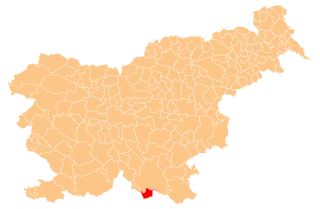| Slavski Laz | |
|---|---|
| Coordinates: 45°28′53.68″N14°54′24.21″E / 45.4815778°N 14.9067250°E Coordinates: 45°28′53.68″N14°54′24.21″E / 45.4815778°N 14.9067250°E | |
| Country | |
| Traditional region | Lower Carniola |
| Statistical region | Southeast Slovenia |
| Municipality | Kostel |
| Area | |
| • Total | 0.95 km2 (0.37 sq mi) |
| Elevation | 222.6 m (730.3 ft) |
| Population (2002) | |
| • Total | 13 |
| [1] | |
Slavski Laz (pronounced [ˈslau̯ːski ˈlas] ; German : Slauskilas [2] ) is a village on the left bank of the Kolpa River in the Municipality of Kostel in southern Slovenia. The area is part of the traditional region of Lower Carniola and is now included in the Southeast Slovenia Statistical Region. [3]

German is a West Germanic language that is mainly spoken in Central Europe. It is the most widely spoken and official or co-official language in Germany, Austria, Switzerland, South Tyrol (Italy), the German-speaking Community of Belgium, and Liechtenstein. It is also one of the three official languages of Luxembourg and a co-official language in the Opole Voivodeship in Poland. The languages which are most similar to German are the other members of the West Germanic language branch: Afrikaans, Dutch, English, the Frisian languages, Low German/Low Saxon, Luxembourgish, and Yiddish. There are also strong similarities in vocabulary with Danish, Norwegian and Swedish, although those belong to the North Germanic group. German is the second most widely spoken Germanic language, after English.

A village is a clustered human settlement or community, larger than a hamlet but smaller than a town, with a population ranging from a few hundred to a few thousand. Though villages are often located in rural areas, the term urban village is also applied to certain urban neighborhoods. Villages are normally permanent, with fixed dwellings; however, transient villages can occur. Further, the dwellings of a village are fairly close to one another, not scattered broadly over the landscape, as a dispersed settlement.

The Municipality of Kostel is a municipality in southern Slovenia. Its seat is the settlement of Vas. It is part of the traditional region of Lower Carniola and is now included in the Southeast Slovenia Statistical Region.
The local church, built on a small elevation outside the village to the northeast, is dedicated to the Holy Trinity (Slovene : Sveta Trojica). It dates to the 17th century. [4]

A church building or church house, often simply called a church, is a building used for Christian religious activities, particularly for Christian worship services. The term is often used by Christians to refer to the physical buildings where they worship, but it is sometimes used to refer to buildings of other religions. In traditional Christian architecture, the church is often arranged in the shape of a Christian cross. When viewed from plan view the longest part of a cross is represented by the aisle and the junction of the cross is located at the altar area.

The Christian doctrine of the Trinity holds that God is one God, but three coeternal consubstantial persons or hypostases—the Father, the Son, and the Holy Spirit—as "one God in three Divine Persons". The three Persons are distinct, yet are one "substance, essence or nature" (homoousios). In this context, a "nature" is what one is, whereas a "person" is who one is. Sometimes differing views are referred to as nontrinitarian. Trinitarianism contrasts with positions such as Binitarianism and Monarchianism, of which Modalistic Monarchianism and Unitarianism are subsets.

Slovene or Slovenian belongs to the group of South Slavic languages. It is spoken by approximately 2.5 million speakers worldwide, the majority of whom live in Slovenia. It is the first language of about 2.1 million Slovenian people and is one of the 24 official and working languages of the European Union.







